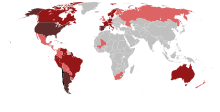
Back Ureuëng Chili ACE Chilene AF Chilean folc ANG تشيليون Arabic تشيليون ARZ Чилиял AV Çililər AZ شيليلار AZB Чылійцы BE ཅི་ལིའི་མི། BO
Chilenos (Spanish) | |
|---|---|
 Map of the Chilean diaspora | |
| Total population | |
| 19,212,362[a] | |
| Regions with significant populations | |
| Total diaspora | 1,037,346[3] |
| 439,582[3] | |
| 138,969[3] | |
| 106,060[3] | |
| 56,138[3] | |
| 45,190[3][4] | |
| 37,608[3] | |
| 30,325[3] | |
| 26,039[3] | |
| 23,296[3] | |
| 19,702[3] | |
| 11,313[5] | |
| 3.199 (2023)"Cileni 2023". | |
| 10,083[3] | |
| 9,000[3] | |
| 8,400[3] | |
| 6,404[6] | |
| 4,413[3] | |
| 2,959[3] | |
| 2,522[3] | |
| 1,000[3] | |
| Other countries combined | 125,324[3] |
| Languages | |
| Chilean Spanish | |
| Religion | |
Predominantly Christian[7]
| |
| Related ethnic groups | |
a. ^ As of 31 December 2019[update]. Based on the projected population of Chile as of 31 December 2019 (19,283,722) minus the non-Chilean population living in Chile as of 31 December 2019 (1,492,522) plus the Chilean population living abroad as of 2016 (1,037,346). | |
Chileans (Spanish: Chilenos, pronounced [tʃiˈlenos]) are an ethnic group and nation native to the country of Chile and its neighboring insular territories. Most Chileans share a common culture, history, ancestry and language. The overwhelming majority of Chileans are the product of varying degrees of admixture between White ethnic groups (predominantly Basques and Spaniards) with peoples indigenous to Chile's modern territory (predominantly Mapuche). Chile is a multilingual and multicultural society, but an overwhelming majority of Chileans have Spanish as their first language and either are Christians or have a Christian cultural background.
However, many Chileans do not equate their nationality with ethnicity, but with citizenship and allegiance to Chile. This has resulted due to immigration to Chile throughout its history, and thus the term "Chilean" can now also include people identifying with the country whose connection may not be ethnic, but cultural, historical, legal, or residential. For most modern Chileans, several or all of these connections exist and are collectively the source of their Chilean identity.
There is a strong correlation between the ratio of a Chilean's European and indigenous genetic components and their socioeconomic situation.[8][9] There is a marked continuum[9] existing between the lower classes of a high component of indigenous ancestry and the upper classes of a predominant component of European ancestry. Indigenous inheritance, whether cultural or genetic, is most pronounced in rural areas and in aspects of culture such as Chilean cuisine and Chilean Spanish. Although post-independence immigrants never made up more than 2% of the population, there are now hundreds of thousands of Chileans with German,[10] British, French, Croatian, Italian or Palestinian[11] ancestry, though these have also been mostly miscegenated with other groups within the country.
Though the majority of Chileans reside in Chile, significant communities have been established in multiple countries, most noticeably Argentina,[12] United States,[13] Australia and Canada and countries of the European Union. Although small in number, Chilean people also make up a substantial part of the permanent population of Antarctica and the Falkland Islands (see: Chileans in the Falkland Islands).[14]
- ^ "Estimación de personas extranjeras residentes habituales en Chile al 31 de diciembre 2019" (PDF) (in Spanish). National Statistics Institute. March 2020. p. 21. Retrieved 25 April 2020.
- ^ "Estimaciones y proyecciones 1992–2050, país (base 2017)" (in Spanish). Retrieved 25 April 2020.
- ^ a b c d e f g h i j k l m n o p q r s "Segundo Registro de Chilenos en el Exterior" (PDF) (in Spanish). National Statistics Institute. January 2018. Archived from the original (PDF) on 17 October 2018. Retrieved 25 April 2020.
- ^ "Ethnic Origin, both sexes, age (total), Canada, 2016 Census – 25% Sample data". Canada 2016 Census. Statistics Canada. 20 February 2019. Retrieved 30 January 2020.
- ^ "Más de 3 millones 400 mil peruanos emigraron al exterior en los últimos 33 años" (PDF). Archived (PDF) from the original on 25 November 2024. Retrieved 25 November 2024.
- ^ "Chile - Emigrantes totales".
- ^ a b "Estudio Nacional de Opinión Pública" (PDF). Centro de Estudios Públicos. October–November 2018. Archived from the original (PDF) on 28 February 2021. Retrieved 2 May 2020.
- ^ Vanegas L, Jairo; Villalón C, Marcelo; Valenzuela Y, Carlos (May 2008). "Consideraciones acerca del uso de la variable etnia/raza en investigación epidemiológica para la Salud Pública: A propósito de investigaciones en inequidades" [Ethnicity and race as variables in epidemiológical research about inequity]. Revista médica de Chile (in Spanish). 136 (5). doi:10.4067/S0034-98872008000500014.
- ^ a b Valenzuela, C. El Gradiente Sociogenético Chileno y sus Implicaciones Etico-Sociales Archived 18 August 2013 at the Wayback Machine, Facultad de Medicina, Universidad de Chile
Quote: Al analizar la composición étnica por estratos sociales nos hemos encontrado con un gradiente sociogenético importante que condiciona la estructura de la morbimortalidad según estrato socioeconómico y la evolución sociocultural de Chile - ^ German Embassy in Chile. Archived 5 August 2009 at the Wayback Machine
Quote in German: Es wird geschätzt, dass zwischen 500 bis 600 Tausend Chilenen deutscher Herkunft sind. - ^ "Los palestinos miran con esperanza su futuro en Chile sin olvidar Gaza e Irak", El Economista, 11 February 2009, archived from the original on 20 July 2011, retrieved 29 July 2009
- ^ "Colectividad chilena, Bajaron de los barcos, ONI". Oni.escuelas.edu.ar. Archived from the original on 27 September 2011. Retrieved 22 September 2011.
- ^ "Top 101 cities with the most residents born in Chile (population 500+)". city-data.com. Retrieved 4 January 2010.
- ^ "Chilenos son atraídos por la bonanza de las islas Malvinas". El Mercurio. 30 March 2007. Retrieved 22 September 2011.